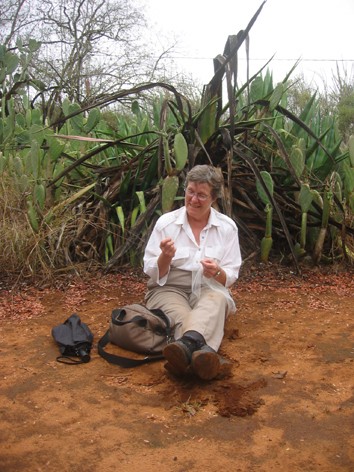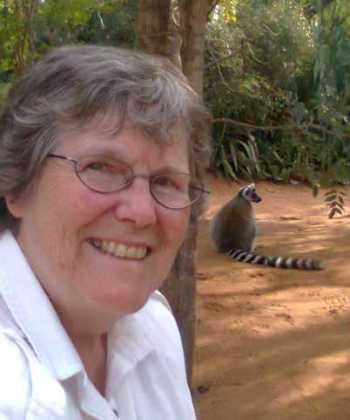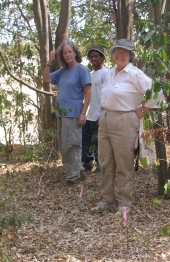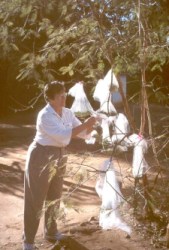Dr. Anne Mertl Millhollen - profile |
Anne Mertl Millhollen studied captive ringtailed lemurs as a graduate student at the Oregon National Primate Research Center. Her research there focused on lemur olfactory communication. After discovering that lemurs could discriminate between the scents from different individuals, she went to Berenty Reserve in 1975 as a Duke University post-doctoral student.Anne found in her research that both the ringtailed lemur and sifaka troops in Berenty's rich gallery forest used scent marks to demarcate territorial boundaries. Amazingly, when she returned 23 years later, one of the ringtailed lemur troops was still using and demarcating those same boundaries. |

"Dr. Anne Mertl Millhollen sewing mosquito-net
|
|||
|---|---|---|---|---|
That research evolved into continuing studies about how food resources, especially tamarind trees, influence ringtailed lemur ranging, territorial behavior and population, and how they all interact in the Berenty ecosystem. |
||||
Further Information |
Education: BA and MAT University of Chicago, PhD University of Oregon.
Present position: Courtesy Research Associate, Department of Anthropology, University of Oregon.
Publications on Berenty:
- Winchester, V., Hardwick, K., Rasamimanana, H., Raharison, S., Mertl-Millhollen, A., Gärtner, H., McCrae, J. (2018). Berenty Reserve a gallery forest in decline in dry southern Madagascar: towards forest restoration. Land, 7, 8, pp. 1-19. doi:10.3390/land7010008. Available online: http://www.mdpi.com/2073-445X/7/1/8/pdf.
- Mertl-Millhollen, A.S., Millhollen, E.L., Raharison, S.M, and Rasamimanana, H. (2015). Ring-tailed Lemur (Lemur catta) Latrines Are Not a Communication Signal at Berenty Reserve, Madagascar. Am J Primatol 77 (S1): 120 (abstract).
- Mertl-Millhollen, A.S., Blumenfeld-Jones, K., Rasamimanana, H., Palagi, E., Needham, J.L., Walker-Bolton, A., Pride, R.E., Kuykendall, A.T., Niemeyer, A. and Peterson, S. (2014). Lemur catta mating behavior at Berenty Reserve, Madagascar: Mating synchrony, indirect female choice and the operational sex ratio. Am J Phys Anthrop Supp 58: 184 (abstract).
- Kelley, E.A., Rasamimanana, H. and Mertl-Millhollen, A.S. (2014). When ring-tailed lemurs find lemons and make lemonade: The dependency on Opuntia at Cap Sainte-Marie and the increasing use of Opuntia at Berenty. Am J Phys Anthrop Supp 58: 156 (abstract).
- Rasamimanana, H., Razafindramanana, J., Mertl-Millhollen, A.S., Blumenfeld-Jones, K., Raharison, S. M., Tsaramanana, D. R., Razoliharisoa, V. and Tarnaud, L. (2013). Berenty Reserve: interactions among the diurnal lemur species and the gallery forest. In: Leaping Ahead: Advances in Prosimian Biology, Masters, J. C., Gamba, M., and Génin, F. G. S (eds.). New York: Springer Media, pp. 361-368.
- Mertl-Millhollen, A.S. (2012). Mating season synchrony of the ring-tailed lemurs at Berenty Reserve, Madagascar: 1964-2011. American Journal of Primatology 74 (S1): 62 (abstract).
- Mertl-Millhollen, A.S., Blumenfeld-Jones, K., Raharison, S.M, Tsaramanana, D.R., and Rasamimanana, H. (2011). Tamarind tree seed dispersal by ring-tailed lemurs. Primates 52: 391-396.
- Mertl-Millhollen, A. S. (2007). Lateral Bias to the Leading Limb in an Olfactory Social Signal by Male Ring-tailed Lemurs. American Journal of Primatology 69: 635-640.
- Blumenfeld-Jones, K., Randriamboavony, T. M., Williams, G., Mertl-Millhollen, A. S., Pinkus, S., and Rasamimanana, H. (2006) Tamarind Recruitment and Long-Term Stability in the Gallery Forest at Berenty, Madagascar. In: Ringtailed Lemur Biology, Jolly, A., Koyama, N., Rasamimanana, H., and Sussman, R. W., pp 69-85.
- Mertl-Millhollen, A. S., Rambeloarivony, H., Miles,W., Kaiser, V. A., Gray, L., Dorn, L. T., Williams, G., and Rasamimanana, H. (2006). The Influence of Tamarind Tree Quality and Quantity on Lemur catta Behavior. In: Ringtailed Lemur Biology, Jolly, A., Koyama, N., Rasamimanana, H., and Sussman, R. W., pp. 102-118.
- Mertl-Millhollen, A. S. (2006). Scent Marking as Resource Defense. American Journal of Primatology (special issue: The Neglected Sense—Olfaction in Primate Behavior, Ecology and Evolution) 68 (6): 605-621.
- Mertl-Millhollen, A. S. (2005). Lateralized Scent Marking by Captive and Wild Male Ring-tailed Lemurs. American Journal of Primatology 66 (S1): 52-53 (abstract).
- Mertl-Millhollen, A. S. (2004). Primate Scent Marking as Resource Defence. Folia Primatologica 75 (S1): 49-50 (abstract).
- Mertl-Millhollen, A. S., Rambeloarivony, H., Miles, W. and Rasamimanana, H. (2004). Tamarind leaf quality and Lemur catta Population Density and Behavior. Folia Primatologica 75 (S1): 157-158 (abstract).
- Mertl-Millhollen, A. S., Moret, E. S., Felantsoa, D., Rasamimanana, H., Blumenfeld-Jones, K.C. and Jolly, A. (2003). Ring-Tailed Lemur Home Ranges Correlate with Food Abundance and Nutritional Content at a Time of Environmental Stress. International Journal of Primatology 24 (5): 969-985.
- Mertl-Millhollen, A.S., Moret, E.S., Felantsoa, D., Rasamimanana, H., Blumenfeld-Jones, K.C. and Jolly, A. (2002). Ring-Tailed Lemur Foraging Correlates with Nutritional Content and Abundance at Berenty Reserve, Madagascar. American Journal of Primatology 57 (suppl. 1): 74 (abstract).
- Mertl-Millhollen, A. (2000). Ringtailed Lemur (Lemur catta) Over-Marking as an Example of Resource Defense. American Journal of Primatology 51 (suppl. 1): 73-74 (abstract).
- Mertl-Millhollen, A. (2000). Components of Scent Marking Behavior by Male Ringtailed Lemurs (Lemur catta) at Berenty Reserve, Madagascar. American Journal of Primatology 51 (suppl. 1): 74 (abstract).
- Mertl-Millhollen, A. S. (2000). Tradition in Lemur catta Behavior at Berenty Reserve, Madagascar. International Journal of Primatology 21: 287-297.
- Mertl-Millhollen, A. S. (1988). Olfactory Demarcation of Territorial but Not Home Range Boundaries by Lemur catta. Folia Primatol, 50: 175-187.
- Mertl-Millhollen, A. S. (1986). Territorial Scent Marking by Two Sympatric Lemur Species. In Chemical Signals in Vertebrates IV, D. Duvall, D. Muller-Schwarze, and R. M. Silvestein, eds. New York: Plenum, pp. 647-652.
- Mertl-Millhollen, A. S. (1984). Olfactory Demarcation of Territorial but Not Home Range Boundaries. Amer. Zool. 24(4): 103A (abstract).
- Mertl-Millhollen, A. S. (1979). Olfactory Demarcation of Territorial Boundaries by a Primate--Propithecus verreauxi. Folia Primatol. 32: 35-42.
- Mertl-Millhollen, A. S., H. L. Gustafson, N. Budnitz, K. Dainis, and A. Jolly. (1979). Population and Territory Stability of the Lemur catta at Berenty, Madagascar. Folia Primatol. 31: 106-122.
- Mertl, A. S. (1977). Habituation to Territorial Scent Marks in the Field by Lemur catta. Behav. Biol. 21: 500-507.
- Jolly, A., H. L. Gustafson, A. Mertl, et G. Ramanantsoa. (1975). Population, espace vital et composition des groupes chez le maki (Lemur catta) et le sifaka (Propithecus verreauxi verreauxi) a Berenty, Republique Malagasy. Acad. Malagache.
Contact: hplam_1998@yahoo.com
 |
|---|
_MASTimg_BreakfastMale_(DC).jpg)
_MASTimg_BerentyWebsiteMasthead.jpg)





